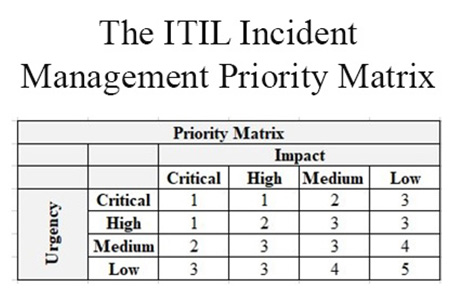
Do you have an ITIL incident management priority matrix? Due to Help Desk resource constraints, not all incidents can be worked on simultaneously. For each incident, a ticket is created in a ticketing application such as ServiceNow. The work order of incident tickets will need to be determined. This work order of incident tickets is based on the priority assigned to the incident tickets.
What is the priority definition in ITIL Incident Management?
The ITIL priority definition of the incident is based on the impact and urgency of the issue. The incident impact is the potential financial, brand, or security damage caused by the incident on the business organization before it can be resolved. Urgency is how quickly incident resolution is required. The incident priority is a matrix of impact and urgency. Incident response and escalations are based on the incident priority levels assigned. Making sure an appropriate priority is assigned to an incident is important for SLAs, response times, and service restorations.
How are incident tickets prioritized?
In ITIL incident management, incident ticket priority is determined by using an ITIL incident management priority matrix. By assessing the impact and urgency of an incident, we can plot the results on the ITIL incident management priority matrix. In our ITIL incident management priority matrix example, we used critical, high, medium, and low as criteria with impact and urgency. To be effective and give guidance to staff assigning an incident priority, you need to define what the criteria mean. An example of this guidance is the following.
management priority matrix. In our ITIL incident management priority matrix example, we used critical, high, medium, and low as criteria with impact and urgency. To be effective and give guidance to staff assigning an incident priority, you need to define what the criteria mean. An example of this guidance is the following.
ITIL Incident Management Impact
In an ITIL incident management priority matrix, the impact is the potential financial, brand, or security damage caused by the incident on the business organization before it can be resolved. The impact is categorized into four levels.
- Critical – A core business IT service is unavailable, causing a direct financial, brand, or security impact on the business organization.
- High – An IT service is unavailable or degraded, impacting a large group of users.
- Medium – An incident impacting a VIP or a small group of users.
- Low – A single user incident.
ITIL Incident Management Urgency
In an ITIL incident management priority matrix, urgency is how quickly incident resolution is required. The incident priority is a matrix of impact and urgency. The urgency is categorized into four levels.
- Critical – A core business IT service is unavailable and must be restored immediately to minimize a direct financial, brand, or security impact on the business organization.
- High – An IT service is unavailable or degraded, impacting a large group of users, and must be restored within 4 hours to minimize a direct financial, brand, or security impact on the business organization.
- Medium – An incident impacting a VIP or a small group of users.
- Low – A single user incident.
Why use an ITIL Incident Management Priority Matrix?
An ITIL incident management priority matrix will lead to higher IT service availability by prioritizing critical incidents and focusing limited resources on resolving them first. Having an incident management program will standardize incident handling processes. With a standard process in place, established criteria will lead to better prioritization of incidents based on impact and urgency. Once the highest priority incidents are identified, incident resolving resources can focus their attention on these IT service-impacting incidents to resolve them quickly. This reduction of time to resolve high-priority incidents will improve IT service availability.
Leave a Reply